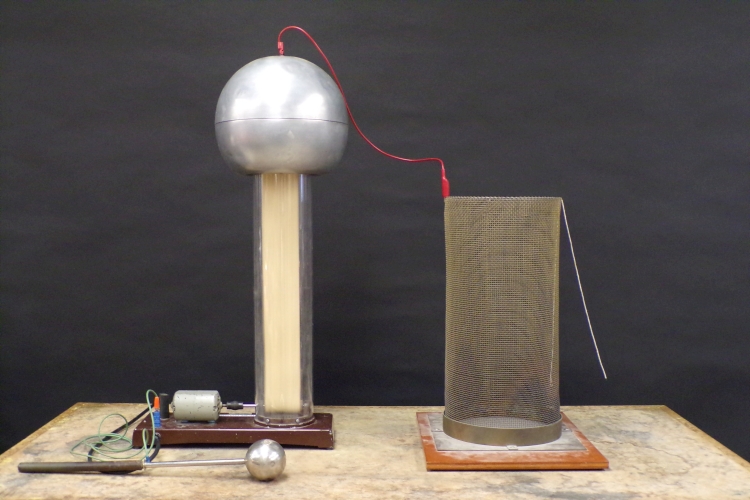
A length of string hangs over the wall of a wire mesh cylinder so that half of the string is inside the cylinder, and half is outside. The mesh cylinder is connected to the dome of the Van de Graaff generator. When you turn on the generator, the string inside the cylinder remains next to the wall, while the string outside the cylinder moves outward. Important! Always use the grounded wand to turn the generator on and off.
When you turn on the Van de Graaff generator, it charges the wire mesh cylinder to a high (in this case, negative) potential. The charge deposited on the wire mesh cylinder stays entirely on the outer surface of the cylinder. As a result, while there is a large electric field outside the cylinder, there is no electric field inside the cylinder. The string on the outside of the cylinder becomes charged in the large electric field there, is repelled by the charged cylinder and rises up to the side. The string on the inside of the cylinder, though, remains hanging down along the inside wall of the cylinder. (See demonstration 56.48 -- Charged hair.)
This is a consequence of Gauss’s law, according to which ΦE = q/ε0, where ΦE is the total electric flux through a closed hypothetical surface (called a Gaussian surface), and q is the charge enclosed by the surface. The flux is the integral of the electric field over the entire surface, or ΦE = ∮E · dS. Putting these together, we have ∮E · dS = q/ε0. Only charge enclosed by the surface contributes to the electric field inside it. Charge outside the surface does not. If we charge the surface, all of the charge moves to the outside, and does not contribute to the electric field inside it. Since there is no charge inside the cylinder, and no electric field, the string hanging on the inside of the cylinder remains lying along the wall of the cylinder. The charge distributed over the outer surface of the cylinder, however, produces an electric field outside the cylinder. The string that hangs along the outside surface of the cylinder becomes charged in the electric field there, is repelled by the charged cylinder and rises up to the side.
References:
1) Halliday, David and Resnick, Robert. Physics, Part Two, Third Edition (New York: John Wiley and Sons, Inc., 1978), pp. 603-6.